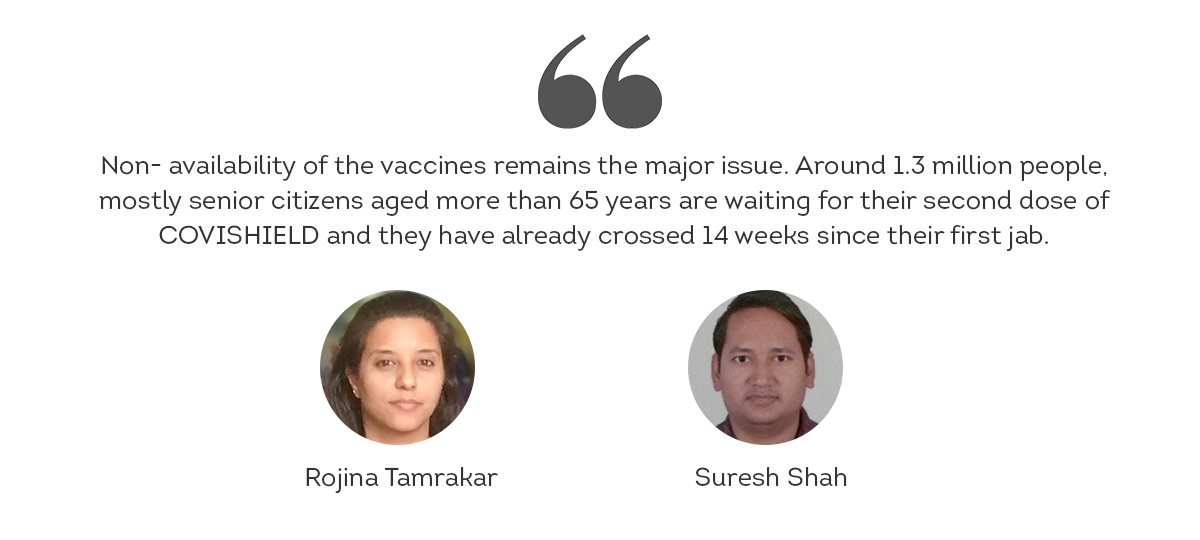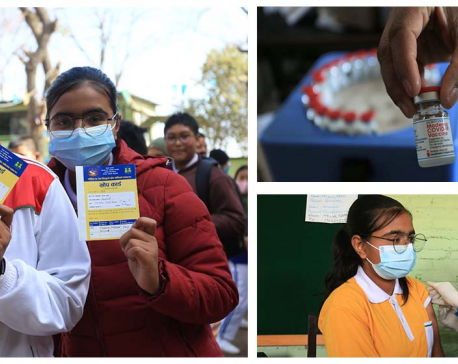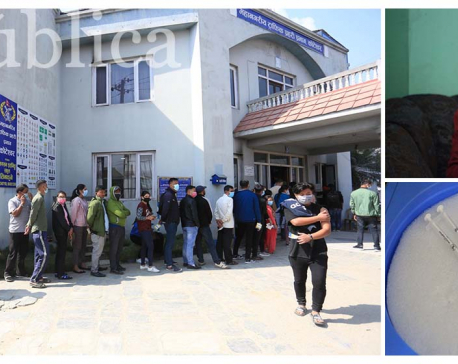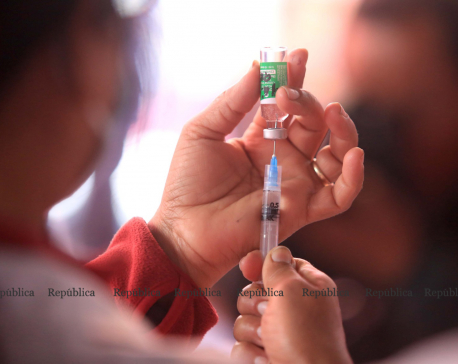
OR
Opinion
COVID-19 Vaccination: Nepal’s status, challenges, and equity issues
Published On: June 28, 2021 08:00 AM NPT By: Rojina Tamrakar and Suresh Shah


Rojina Tamrakar and Suresh Shah
(The authors are public health practitioners working on COVID-19 response.)news@myrepublica.com
More from Author
The second wave of the COVID-19 pandemic is slowly receding, and hopefully, we could overcome this crisis. Our healthcare systems need to be strengthened to prepare for the future wave of COVID-19 or a similar pandemic.
With the surge of the Covid-19 pandemic, 2020 was an unpredictable and tough year in the history of Nepal. As Nepal was struggling with the multisectoral effects of the pandemic and dealing with the aftermaths of the first wave, the vaccines emerged as a new hope. The Government of India declared to provide Nepal with COVID-19 vaccines under grant assistance in January 2021. One million doses of the COVISHIELD vaccine, manufactured by the Serum Institute of India arrived from India. It was approved for emergency use by the Department of Drug Administration on Jan 15, 2021. The immunization section at the Family Welfare Division under the Department of Health Services worked promptly in developing vaccination guidelines, preparing vaccination cards, orienting districts as well as vaccinators through virtual means on supply chain management and other preparatory planning activities. And thus, the first phase of the vaccination campaign started on Jan 27, 2021, including frontline health care workers, supporting staff working at health facilities, female community health volunteers (FCHVs), ambulance drivers, dead body management teams, senior citizens at old age homes and security personnel working at Point of Entry (PoE). In later phases, COVISHIELD was introduced to government officials, elected representatives, media personnel, security personnel, and people above 65 years. The Government of Nepal procured two million doses from Serum Institute, but only 1 million doses were received. The Serum Institute declined to supply the remaining one million doses following an Indian High Court order.
Similarly, to date, 1.8 million doses of Vero Cell, manufactured by Beijing Institute of Biological Products, Under Sinopharm, China have been received as grant assistance from the People’s Republic of China. The Vero Cell vaccine was inoculated to people aged 45-60 years in the Kathmandu Valley and bordering districts of Nepal to China during the earlier phase and those going to China for study, travel, or work. The Vero Cell first dose was also given to the age group 62-64 years.
As of today, 8.5% of the population (around 2.6 million) has received at least one dose of the vaccine. However, just 2.4% of the population is fully immunized, which is low in comparison with other South Asian countries and the global average. The Department of Drug Administration (DDA) under the Ministry of Health and Population had provided emergency authorization approval to other three vaccines which include Sputnik V (Gamalaya, Russia), COVAXIN (Bharat Biotech, India), and CoronaVac. (Sinovac Life sciences, China). However, they have not been received by Nepal.
Challenges and the equity issues
Non- availability of the vaccines remains the major issue. Around 1.3 million people, mostly senior citizens aged more than 65 years are waiting for their second dose of COVISHIELD and they have already crossed 14 weeks since their first jab. The WHO’s COVAX facility could deliver just a handful of 380,000 doses of AstraZeneca’s COVISHIELD. Meanwhile, the already promised age group 55-60 years have not received the vaccine. Another issue is the demand for immunization from other sectors like industrial, transportation, education etc. Also, community-level health workers mobilized for vaccination are receiving pressure from elite groups to vaccinate those who don’t belong to the targeted group. So, the priority set by the government has been challenged. The equity in healthcare is under scrutiny. The scenario is likely when we compare the vaccination status of Nepal with other South Asian nations' status.
2. Private sector engagement: The government vaccination campaign conducted to date was free of cost for the public. The government has finally called the private sector for procurement of vaccines from the manufacturers. However, it's quite possible that if the private sector succeeds in bringing vaccines, there are chances that the public may have to bear high expenses (out-of-pocket expenditures). We have already witnessed one such instance where the private sectors charged as high as Rs 15,000 for a PCR test. In the situation, where the income of the public has suffered due to restrictive measures like lockdown, the cost of the vaccine is a big issue. Financial affordability will widen the gaps in society between the haves and have-nots, which might result in social conflicts as resources are scarce. In such testing times, such conflicts may prove detrimental to the stability of the nation. The government can authorize the cost for the vaccine, but the government monitoring systems need to be robust. Instead, the government could reimburse the cost of vaccination from the client’s side. Therefore, the government must rethink the engagement of the private sector in vaccination, as it will question equity within society.
Access to vaccines: Nepal has a difficult geographical terrain, and it has been one major barrier to accessing healthcare services. COVID vaccination is just another healthcare issue on that list. People had to travel for days from rural parts to the district headquarters for vaccination. A major concern is about the transportation of vaccines, across the mountain and hilly terrain amidst the unpredictable monsoon season. In the first phase of the vaccination campaign, the vaccine was new and vaccination centers were placed at the district or municipality level to address the possible Adverse Effects Following Immunization (AEFIs). So, the government should be proactive and plan to ensure availability and access of vaccines, health workforce, and other commodities in the remote districts.
4. Vaccine storage and transportation infrastructure: The storage capacity of the central as well as provincial warehouses is not enough. This is also one of the reasons for receiving just half the procured amount of COVISHIELD from Serum institute. Also, the vaccines which need much lower temperature such as Pfizer or Moderna vaccines could not be used in the current settings due to the constraints in storage and transportation. So, there is some sort of compulsion to the government to procure vaccines which could be stored at 2-8 degrees, on which the community health workers are better experienced. So, the government must increase the storage capacity at national and sub-national warehouses.
5. Vaccine hesitancies were observed during the initial rollout of vaccination. Even health professionals doubted the safety of the new vaccine. There were lots of trust issues over this vaccination campaign. People were concerned about side effects, and they were unwilling to take the shots. This resulted in low vaccination coverage, which matters significantly in increasing chances of failure in breaking the chain of COVID infection. However, now people are willing to go for the vaccination. The government has been transparent in information sharing, raising awareness on the impacts of COVID vaccination, addressing the queries and health concerns of the public before and after vaccination, dealing with misinformation and rumors.
Our healthcare system has been trying its best to deal with this pandemic. The health care settings are overburdened due to the crisis of health workers. There are overworked and exhausted frontline health workers who are on the brink of breakdown due to exhaustion as they have been away from rest, home, and loved ones. And they are working in a risky environment including that of violence from the patient party. There has been an incident recently in Banke district where two health care workers had to jump off the window on the first floor of the hospital to save their lives from the perpetrators. Such incidents demoralize, frustrate healthcare workers across the nation who have been risking their own lives for serving the public. As a result of some voiced opinions and demonstrations, the government has endorsed an ordinance on safeguarding health workers and health institutions, especially from violence from the patient party. However, there is a massive challenge in the implementation part.
It is necessary to consider the greater impacts of COVID-19 on the non-health sectors as well. The country is under prohibitory orders for two months. It has had great socio-economic impacts on the public; the most affected are daily wage-workers, who have lost their livelihoods. There is a growing concern over how the economic impact would affect the social and psychological status of individuals. This is an inevitable consequence that should not be ignored. There should be some supporting policies for all groups in society from the government when such restrictive measures are imposed. The greater question remains how long will such restrictive measures hold the status quo? Is there a need to find an alternative way to deal with the waves of this pandemic? The pandemic is a multisectoral issue, which to tackle requires multisectoral efforts. Adopting public health measures such as contact tracing, social distancing, hands as well as respiratory hygiene (wearing masks) should be advocated and promoted fiercely. And it should be done through all the sectors, groups, institutions, communities until the public is aware, committed, and behaving accordingly.
The second wave of the COVID-19 pandemic is slowly receding, and hopefully, we could overcome this crisis. Our healthcare systems need to be strengthened to prepare for the future wave of COVID-19 or a similar pandemic.
Lastly, we would like to congratulate all for the waiver of intellectual property rights on COVID-19 vaccines. Nepal will also be benefitted to some extent from this. To make a just and equitable distribution of vaccines, all governments across the globe should act collaboratively. There needs to be coordination and collaboration between the three tiers of the government in Nepal as well. We had expected similar solidarity from the recent G7 summit. WHO, being a major player for COVAX, should take the lead and make diplomatic efforts to have political dialogues with the countries to ensure the fairer use of vaccination. The Director-General of WHO was alarmed by saying, “The world is on the brink of a catastrophic moral failure- and the price of this failure will be paid with lives and livelihoods in the world’s poorest countries.” There are even frontline health workers abandoned from vaccination in some least developed countries. As we live in a global village, good coverage of vaccination to the people of the planet is needed to beat the pandemic. So, there is an urgent need for cooperation and collaboration among all the governments, world health leaders, and vaccine manufacturers with the single agenda of saving humanity.
(The authors are public health practitioners working on COVID-19 response.)
You May Like This

Children aged 12-17 getting vaccines against COVID-19 (With Photos)
KATHMANDU, Jan 11: Students line up to get a shot of vaccine against COVID-19 at Suryabinayak Municipality in Bhaktapur on... Read More...

People leaving for their hometowns to celebrate Tihar being vaccinated against COVID-19 (With photos)
KATHMANDU, Nov 2: The Ministry of Health and Population (MoHP) has set up vaccination centers at Gongabu Bus Park, Kalanki,... Read More...

Vero Cell and J&J vaccines being administered across country from today
KATHMANDU, July 13: The government is administering the first dose of vaccine against COVID-19 from Tuesday. The vaccines — Vero... Read More...





Just In
- MoHP cautions docs working in govt hospitals not to work in private ones
- Over 400,000 tourists visited Mustang by road last year
- 19 hydropower projects to be showcased at investment summit
- Global oil and gold prices surge as Israel retaliates against Iran
- Sajha Yatayat cancels CEO appointment process for lack of candidates
- Govt padlocks Nepal Scouts’ property illegally occupied by NC lawmaker Deepak Khadka
- FWEAN meets with President Paudel to solicit support for women entrepreneurship
- Koshi provincial assembly passes resolution motion calling for special session by majority votes






_20220508065243.jpg)






Leave A Comment